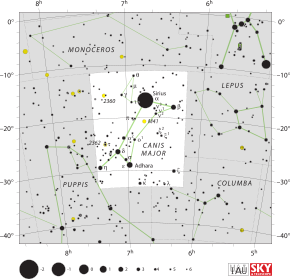Canis Major
| Constellation | |
 | |
| Abbreviation | CMa |
|---|---|
| Genitive | Canis Majoris |
| Right ascension | 7 |
| Declination | −20 |
| Area | 380 sq. deg. (43rd) |
| Main stars | 8 |
| Bayer/Flamsteed stars | 32 |
| Stars with planets | 3 |
| Stars brighter than 3.00m | 5 |
| Stars within 10.00 pc (32.62 ly) | 1 |
| Brightest star | Sirius (α CMa) (−1.46m) |
| Messier objects | 1 |
| Meteor showers | None |
| Bordering constellations | Monoceros Lepus Columba Puppis |
| Visible at latitudes between +60° and −90°. Best visible at 21:00 (9 p.m.) during the month of February. | |

Canis Major (Template:Pron-en, genitive Canis Majoris /ˈkeɪnɨs məˈdʒɒrɨs/) is a constellation, included in the 1st century astronomer Ptolemy's 48 constellations, and still included among the 88 modern constellations. Its name is Latin for 'big dog', and is commonly represented as one of the dogs following Orion the hunter (see also Canis Minor the 'lesser dog'). Canis Major contains Sirius, the brightest star in the night sky, known as the 'dog star'; that star is part of the asterism known as the Winter Triangle in the Northern Hemisphere, or the Summer Triangle in the Southern.
Notable features
Stars
Canis Major's alpha star, Sirius, is the brightest object in Earth's sky after the Sun, Moon, Jupiter, and Venus. It is also one of the nearest stars to Earth. The star VY Canis Majoris (VY CMa) is a red hypergiant star in Canis Major. It is the largest known star and also one of the most luminous known. It is located about 1.5 kiloparsecs (or 5,000 light-years) from Earth.
There are several other fairly bright stars (in order of brightness) in Canis Major, all with Arabic names:
- ε CMa: (1.51v) Adhara - Virgins
- δ CMa: (1.83) Wezen - The Weight
- β CMa: (1.98v) Murzim - The Announcer
- η CMa: (2.45v) Aludra - the virgin
- ζ CMa: (3.02) Furud - Bright Single One
- γ CMa: (4.11) Muliphen - the Arabic rendering of the Greek for "dog's ear".
Deep sky objects
There are not many bright deep sky objects in this region of sky. The only Messier object in Canis Major is Messier 41 (NGC 2287), an open cluster of visual magnitude 4.6. It is located about 4 degrees directly south of Sirius. Messier 41 is roughly 2350 light years away from Earth, contains about 8,000 stars, and is about 24 light years in diameter. It is also noted for containing a number of K-class stars.
The band of the Milky Way goes through Canis Major and therefore background galaxies are hidden behind interstellar dust clouds. However, in 2003, Canis Major Dwarf, the closest satellite galaxy to Earth, was found within the constellation.
History
In Europe, Canis Major has been associated with dogs from early times. The name of Sirius, its brightest star, means "scorching star", since the summer heat occurred just after Sirius' heliacal rising. The Ancient Greeks referred to such times in the summer as dog days, as only dogs would be mad enough to go out in the heat, leading to the star being known as the Dog Star. Consequently, the constellation was named after it, as a 'Big Dog'.[citation needed]
Mythology
In early classical Europe, Canis Major represented the dog[1] Laelaps, a gift from Zeus to Europa; or sometimes the hound of Procris, Diana's nymph; or the one given by Aurora to Cephalus, so famed for its speed that Zeus elevated it to the sky.
It was also considered to represent Orion's hunting dog, pursuing Lepus the Hare or helping Orion fight Taurus the Bull; and is referred to in this way by Aratos, Homer and Hesiod. The ancient Greeks refer only to one dog, but by Roman times, Canis Minor appears as Orion's second dog.[citation needed]
Sirius was considered a dog in its own right, early Greek mythology sometimes the constellation to represent a two-headed dog. As such, together with the area of the sky that is deserted (now considered as the new and extremely faint constellations Camelopardalis and Lynx), and the other features of the area in the Zodiac sign of Gemini (i.e. the Milky Way, and the constellations Gemini, Orion, Auriga, and Canis Minor), this may be the origin of the myth of the cattle of Geryon, which forms one of The Twelve Labours of Heracles.[original research?]
Roman myth refers to Canis Major as Custos Europae, the dog guarding Europa but failing to prevent her abduction by Jupiter in the form of a bull; and as Janitor Lethaeus, the watchdog. [citation needed]
Visualizations
Depending on the faintness of stars considered, Canis Major can be shown to resemble a dog facing either above or below the ecliptic.[citation needed]
See also
Notes
- ^ reference needed
References
- Ian Ridpath and Wil Tirion (2007). Stars and Planets Guide, Collins, London. ISBN 978-0007251209. Princeton University Press, Princeton. ISBN 978-0691135564.
